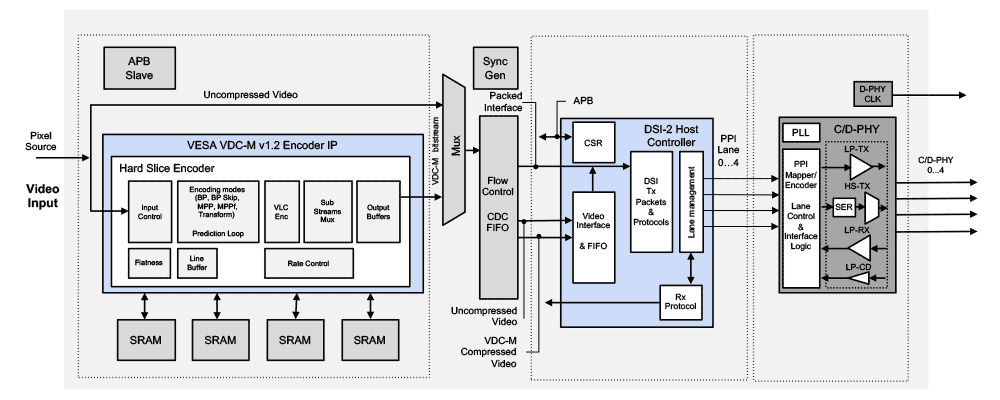VESA DSC and VDC-M Video Compression IP Cores
Home > Interface IP > VESA Video Compression IP Cores
VESA DSC and VDC-M Video Compression IP
Rambus VESA® Display Stream Compression (DSC) and VDC-M encoder and decoder IP cores deliver visually lossless video compression performance, enabling designers to handle the growing bandwidth requirements of cutting-edge displays with higher resolutions, faster refresh rates, and greater pixel depths.
| Standard | Encoder ASIC | Decoder ASIC | Encoder AMD FPGAs | Decoder AMD FPGAs | Encoder Intel FPGAs | Decoder Intel FPGAs |
|---|---|---|---|---|---|---|
| VESA DSC | ||||||
| VESA VDC-M |
VESA DSC and VDC-M IP
| Feature | VESA DSC | VESA VDC-M |
|---|---|---|
| Encoding Block Structure | 3×1 pixels | 8×2 pixels |
| Visually Lossless Performance (bits per pixel) | 8 bpp | 5-6 bpp |
| Bits Per Video Component | 8/10/12/14/16 | 8/10/12 |
| Encoding Mechanisms | BP ICH MPP MMAP |
BP BP Skip MPP MPP Fallback Transform |
| Latency (end-to-end) Example: UHD 3840 x 2160 |
<0.5us <2H line |
<1.2us <5H line |
| RGB and YCbCR 4:4:4 Native Encoding |
Yes | Yes |
| YCbCR 4:2:0/4:2:2 Native Encoding |
Yes | Yes |
| HDR Ready | Yes | Yes |
| Pixels/Clock Architecture | Encoder: 1 Decoder: 3 |
Encoder: 2 Decoder: 4 |
| Backward Compatibility | DSC 1.x | VDC-M 1.x |
Video Compression Performance of VESA DSC and VDC-M
The Rambus VESA DSC and VDC-M IP cores deliver visually lossless video compression for mobile, AR/VR and automotive display applications.
The VESA DSC IP cores can compress any image to 8 bits per pixel (bpp), which results in a 3X compression ratio for a 24 bpp image or a 3.75X compression ratio for a 30 bpp image. The VDC-M cores use more sophisticated video encoding tools to achieve even higher compression factors for applications that require even more compression. VDC-M can reduce a 30 bpp uncompressed image to 6 bpp, and in some use cases, it can be visually lossless at a 6X compression ratio.
The VESA DSC and VDC-M IP cores can be combined with the Rambus MIPI DSI-2 Controller cores, and your choice of C/D-PHY, to form a complete display solution.

MIPI Drives Performance for Next-Generation Displays

MIPI® Alliance technology has helped enable the dramatic growth of the mobile phone market. The function and capabilities of MIPI interface solutions have grown dramatically as well. MIPI DSI-2SM has become the leading display interface across a growing range of products including smartphones, AR/VR, IoT appliances and ADAS/autonomous vehicles. As the application space has expanded, so too have the performance requirements. Learn how MIPI DSI-2 interface and VESA® DSC visually lossless compression technologies can meet the challenges of next-generation displays.
VESA DSC Encoder & Decoder
- VESA Display Stream Compression (DSC) 1.2b compliant
- Supports all DSC 1.2b mandatory encoding mechanisms: MMAP, BP, MPP, and ICH
- Output buffering compatible with transport stream over video interfaces
- Configurable maximum display resolution
- Configurable compressed bit rate, in increments of 1/16 bpp
- 8, 10, 12, 14, and 16 bits per video component
- YCbCr and RGB video input format
- 4:4:4, 4:2:2, and 4:2:0 native coding
- 1 pixel / clock (Encoder) and 3 pixels / clock (Decoder) internal processing architecture in 4:4:4
- 2 pixel / clock (Encoder) and 6 pixels / clock (Decoder) internal processing architecture in 4:2:2 and 4:2:0
- Parameterizable number of parallel slice encoder instances (1, 2, 4, or 8) to adapt to the capability of the technology and target display resolutions used
- Multiple slices per line in each encoder instance supported
- 100% verification coverage based on UVM environment
- Verified against the VESA DSC 1.2b C model using a comprehensive test image library
- Backward compatible with DSC 1.1
VESA VDC-M Encoder & Decoder
- VESA Display Compression-M (VDC-M) 1.2 compliant
- Supports all VDC-M encoding mechanisms: BP, transform, MPP, MPP fallback, BP skip, flatness detection and signaling
- Configurable maximum display resolution of up to 16Kx16K
- Configurable compressed bit rate, in increments of 1/16 bpp
- 8, 10, or 12 bits per component video
- 4:4:4 sampling for RGB video input format
- 4:4:4, 4:2:2, and 4:2:0 sampling for YCbCr video input formats
- 2 pixel / clock (Encoder) and 4 pixels / clock (Decoder) internal processing architecture
- Parameterizable number of parallel slice encoder instances (1,2, 4, or 8) to adapt to the capability of the technology and target display resolutions used
- Supports logical slice encoding (soft slice) in each physical encoder (hard slice)
- 100% verification coverage based on UVM environment
- Verified against the VESA VDC-M 1.2.2 C model using a comprehensive test image library
- Verilog RTL
- Testbench (source code)
- Complete documentation
- Expert technical support
- Maintenance updates
- Engineering design services
- Customization
- SoC integration



